Most Popular Pet Snake Breeds
With so many different breeds of snake in the world, you may be wondering, what are the most popular snake breeds to have as pets? If you’re looking for an amazing pet that is containable, easy to care for, and overall fun, then a snake is the best pet for you!
Which breeds
- Ball pythons
- King snakes
- Corn snakes
- Milk snakes
- Boa constrictors
This is largely due to their docile temperaments and low maintenance requirements.
But you don’t just want to choose a random snake. Owning a snake is a long-term commitment. You will want to learn the proper information about different snakes you are considering before you make any decisions.
Ball Pythons
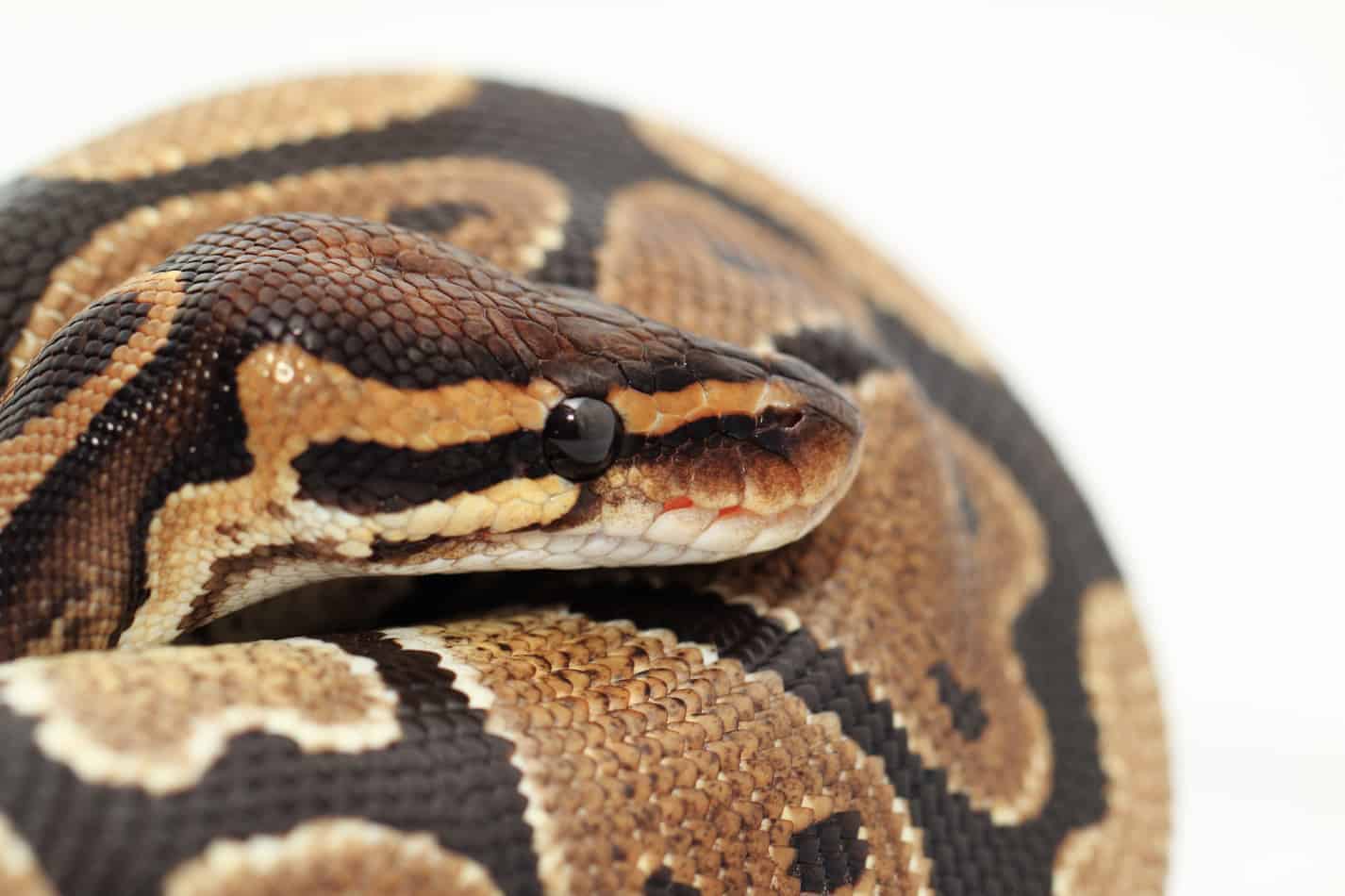
The ball python, or otherwise called python regius, is the most popular snake among pet snake owners. These shy snakes are native to the warm areas of central and western Africa, mostly north of the equator.
Ball pythons are naturally shy creatures which make them wonderful pets. These snakes are a draw for many people because they come in many different colors and patterns.
Every snake is different which means your pet snake will be a one of a kind. These snakes usually tend to grow to between four and five feet once they’ve met their maturity and they can even live up to thirty years!
Pythons are constrictors and are, therefore, non-venomous. This means that if your ball python does happen to bite you, the bite won’t be serious. Just make sure you clean and sanitize it well. In fact, we have a whole article dedicated to informing people about what happens when a ball python bites. We include a complete medical guide, showing you step by step what to do if you are bitten, as well as how to avoid being bitten. Find it here.
Because pythons can’t kill with poison, they hunt by luring their prey and coiling their bodies so tight around the victim that the blood flow to the brain is cut off. This, and not suffocation, is what ultimately kills the prey of the constrictors.
In captivity, however, this isn’t something you shouldn’t have to worry much about. Exercise caution in your interactions with your snake, pay attention to its temperament, and you should be just fine.
As stated before, ball pythons are extremely shy and will spend most of their time hiding, especially when first brought into a new home with new owners. It is important to gain the trust of your snake over time.
They will enjoy being handled by you after a level of trust has been established and your snake knows you are not a threat. Be aware of them and signs of discomfort.
Sometimes excessive fear may cause them to lash out and bite. When you are handling your pet python, be sure to support their body and do not make quick or sharp movements, as this may scare the snake.
When considering what to house your ball python in, depending on your snake’s size, a thirty-gallon tank/terrarium should suffice. When choosing a terrarium or tank be sure that you have a closed lid for it, not a screen.
Ball pythons are derived from humid environments and need to be comfortable. With a screened top you will not be able to keep your snake’s enclosure humid which will lead to the discomfort of your ball python.
Your snake should have a warm side and a cool side of its tank. The warm side should be around ninety-five degrees Fahrenheit while the cool side should be seventy-eight degrees Fahrenheit. Here, you can find an article on our website talking about the best enclosures for ball pythons. It talks about the best type of tanks, sizes of tanks, and other important information.
Things you should also include inside your snake’s habitation is a proper substrate (coconut fiber and others are great), a hide box due to your snake’s shy nature. It is recommended that you have two hide boxes in your snake’s tank, one for the warm side and another for the cool.
Ball pythons should also be provided with eight to ten hours of sunlight each day. If your snake’s enclosure does not have access to natural light, it would be a good idea to invest in a light for its enclosure.
A nocturnal light should be used at night. It is also important for your snake to have access to clean water. A sturdy metal bowl should be used to keep water in and should be big enough for your snake to soak in if desired. In this case, be sure that the water will not overflow when your snake decides to cool off.
When it comes to the diet of your snake, ball pythons are carnivorous. This means that they are meat eaters. A captive ball python’s key meal consists of rodents such as mice and rats. You should feed your ball python every one or two weeks. For pet snakes, giving them pre-killed food should is ideal, as it prevents injury to your snake.
Be aware that there are certain times in the year when the ball python does not eat. Do not be alarmed at this, just keep an eye out for your snake’s overall appearance and well being.
In all, ball pythons are amazing pet snakes to have in your life and in your home. They are very shy and kind creatures, if taken care of properly, and you will gain much from having a great snake like this. Ball pythons can live up to thirty years in captivity, so you will have a companion for a very long time with one of these snakes.
If you think that a ball python is right for you, check out this link to find an article we recently wrote all about ball pythons for beginners.
California King Snakes
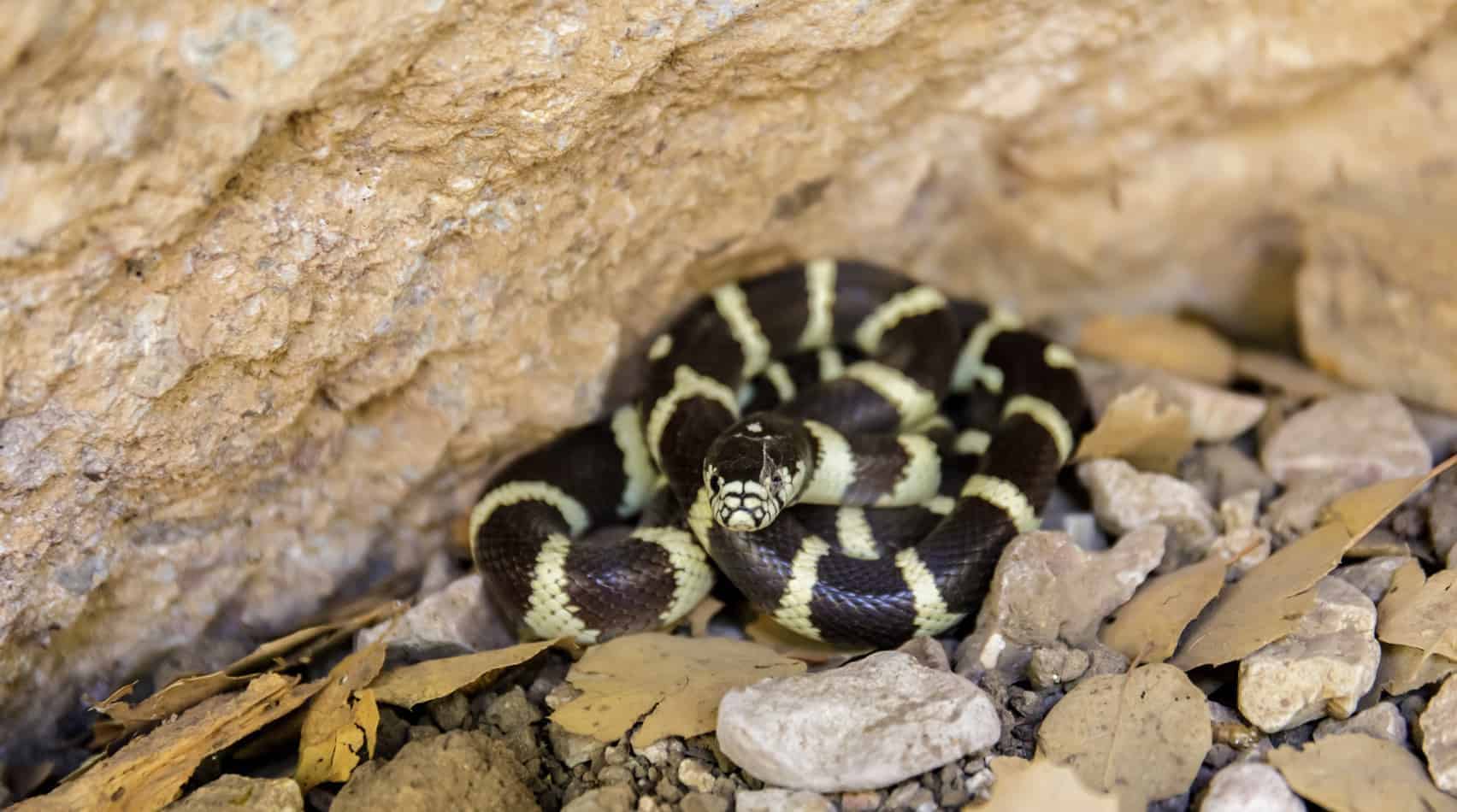
King Snakes are extremely popular snakes to have in the home as pets. There are many different specific types of King Snakes but the most popular is the California King Snake, also known as Lampropeltis getula californiae.
These snakes are from the areas of the western United States, such as Nevada, Arizona, California, and Oregon. They can also be found in Northwestern Mexico, New Mexico, and Baja California.
These snakes make popular pets because of their various patterns and colors. Some King Snakes, like the one in the picture above, are black and white with stripes, but some are black and white with spots, almost a salt and pepper pattern.
Other King Snakes have adopted a red, black, and yellow pattern to mimic the highly venomous Coral Snake. However, though the patterns between King Snakes and Coral Snakes can be similar, the order of the colors will not be the same. There are lots of interesting and cool facts about King Snakes that I recently wrote an article all about. Find the article here.
Much like the ball python, California King Snakes will take a while to settle into their new environment once adopted into your home. At first, they will be nervous with new handling because they don’t know you and may see you as a threat.
Signs of discomfort include smearing feces and urine on your skin and taking a defensive stance or shaking its tail before striking. But again, in the same way as the ball python, with regular handling your new snake will get used to you and will soon be comfortable with you handling them.
These non-venomous constrictors can grow on average up to three and four feet, but they start off pretty small. As infants, they are only eight to ten inches long, so if your King Snake is a baby, it can probably start in a smaller tank than an adult. King Snakes have been recorded as reaching up to six feet long, so be prepared to house a snake twice as big as you expected just in case.
California King Snakes should have at least twenty gallon enclosures or bigger for the best comfort. When choosing a terrarium or tank for your snake be sure that it is very secure. California King Snakes are very curious by nature and are excellent escape artists, given the opportunity they will find a way out of their habitations.
Also, like the ball python, your California King should have a warm and cool side to their tank with the cooler side being in the seventies Fahrenheit and the warmer end being around eighty-five degrees. Heating rocks nor heating lamps should be used because it could burn your snake. Instead, tools like heating pads, cables or tape can do the trick.
Proper substrate for your snake is needed also. A substrate can consist of clean newspaper, indoor carpet, or paper towel. When buying other substrate make sure that there are no harmful chemicals involved. Usually, if it looks clean and doesn’t smell like chemicals it is okay to use. Freshwater in a container big enough for your snake should also be provided.
The California King Snake’s diet should consist of appropriately sized rodents, which is mainly mice for snakes in captivity. It is recommended that you feed your snake freshly killed rodents because feeding your snake live mice may cause harm to your snake.
The California King Snake, while very similar to the King Snake, is unique in its own special way. They are called King because they are the kings of their own environment. They are capable of killing other snakes around them and eating them in the wild which earns them the name. The California King Snake, with all its survival skills, can live to up to twenty years!
If you want a long-term commitment with a California King Snake, here can find an article on our website that includes a complete guide on how to have a king snake as a pet.
Corn Snakes
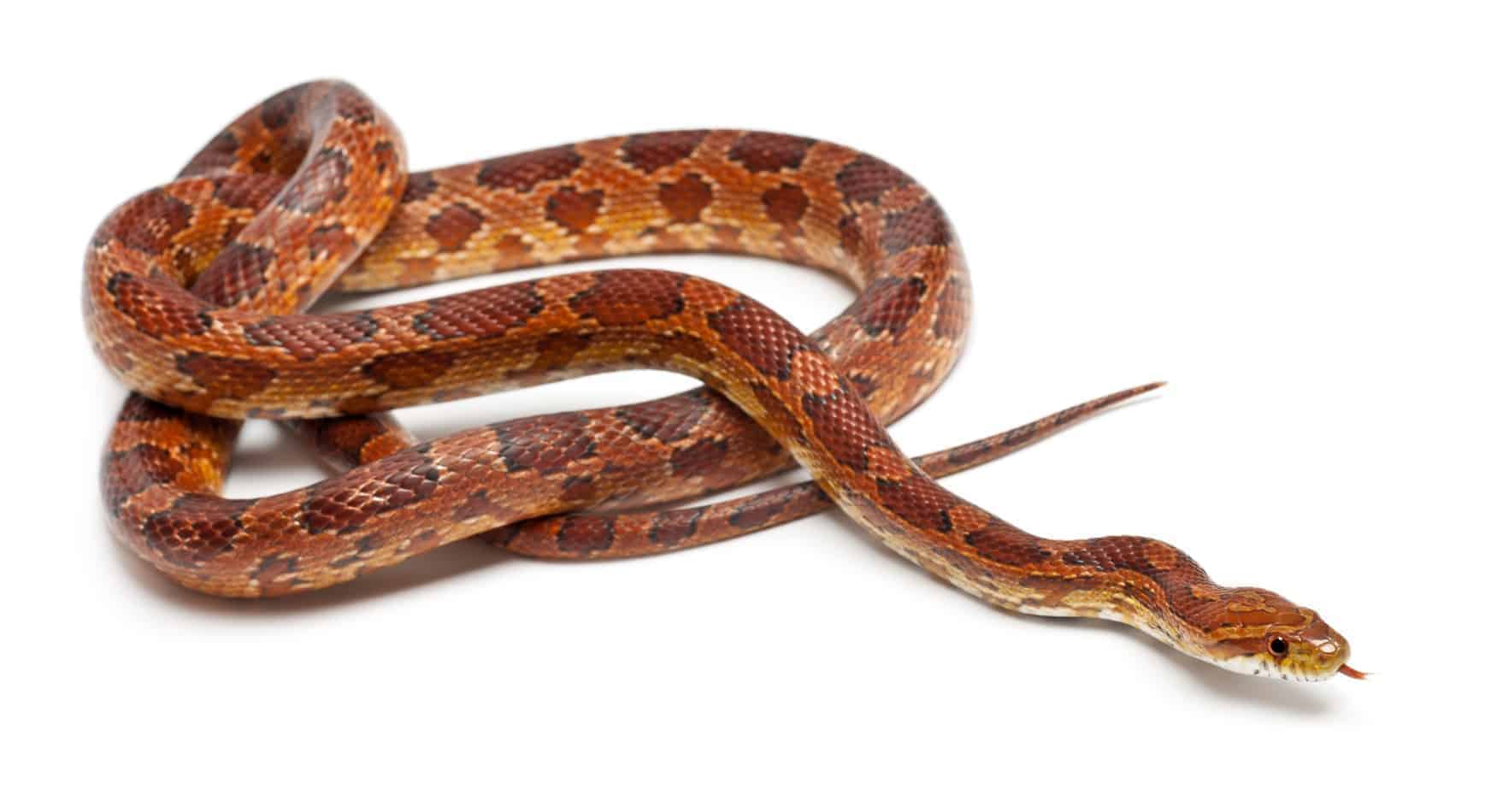
Corn snakes or,
Corn snakes are also nonvenomous (I’m sensing a common theme here), which means they also constrict their prey when they hunt. Though corn snakes can be a bit nervous and flighty, they have a generally calm temperament, so constriction shouldn’t be a problem. They are also small enough snakes that they shouldn’t be able to hurt a human. Here, you can find an article all about the temperament of corn snake’s, along with if they’re good with kids, and how to take care of them in the best way.
These snakes make their way onto this list because of their beautiful array of patterns and colors. These
Corn snakes need a few weeks to settle into their new homes. They tend to be shy at first and may try to flee when handled. You can start handling them after their first few meals. When handling, you should approach to pick up your snake from the sides rather than above like a predator would. You should lift gently but do not be shy. Be sure in your movements.
An enclosure for your pet corn snake should be at least twenty gallons long and especially secure. Like the other snakes on this list, given the opportunity, your corn snake will find it and take it to escape. Because your corn snake may be shy at times, some hiding spots will be appreciated as well as some climbing branches.
While no special lighting is required, natural daylight will be good for your snake to adjust to the cycles of day and night. Your corn snake’s enclosure should not be in the direct sunlight.
This is because the enclosure can quickly become heated to the point where the heat can kill your snake. The temperature of your snake’s tank should be kept between seventy and eighty-five degrees Fahrenheit. Again seventy for a cool end and eighty-five for the warm end.
Aspen shavings have been known to be a good substrate and fungus and mold should be kept in your snake’s terrarium/tank. In circumstances where a
Corn snakes, unlike the other two snakes listed, can have a bit more of a varied diet. Baby corn snakes can eat baby mice, but can also eat small frogs and lizards. Adult corn snakes are known to eat birds and can eat the bird’s eggs.
In captivity, appropriately sized rodents such as mice are the most common. A corn snake that has reached its full adult maturity should be fed once every seven to ten days.
These colorful snakes would make a great addition to any home due to their easy care, calm nature, and various colors and patterns. The corn snake’s lifespan is a bit on the shorter side, spanning between six to eight years, though some do live into their teens.
If you’ve decided you need more
Milk Snakes
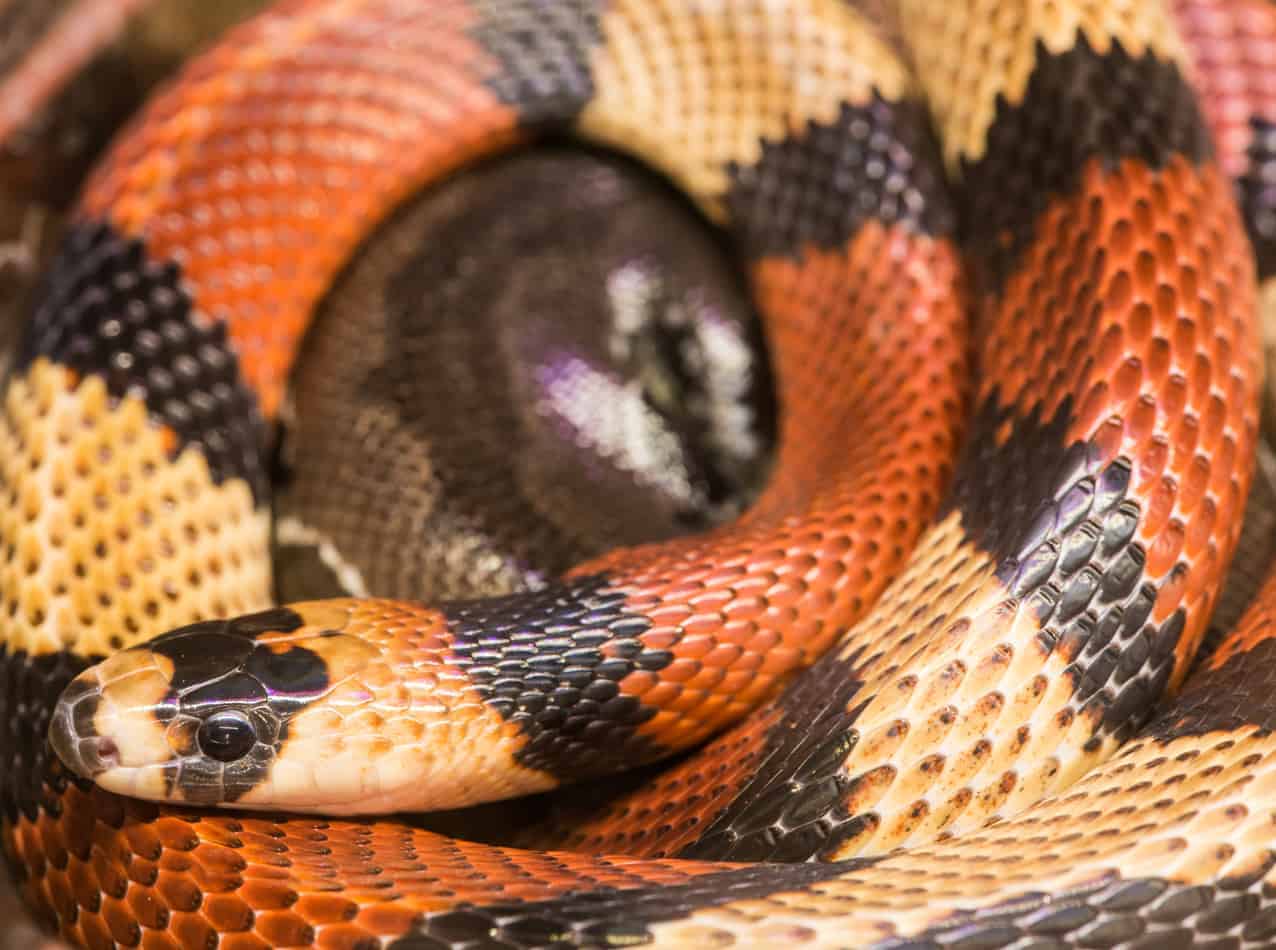
Milk Snakes consist of twenty-four Lampropeltis triangulum species, and are known as one of the most beautiful snake species in the world. These snakes can be found in a wide range from North and South America.
These snakes can grow up to six feet depending on the subspecies of milk snake you choose to adopt into your home. Here, you can find an article all about how long milk snakes can get and how long it takes them to grow to their full size. What draws this snake to be one of the most popular snakes is their defining red, black, and white stripes it can be patterned and decorated with.
When it comes to the behavior of Milk Snakes, they are mainly nocturnal which means they are most active at night. They are solitary creatures but can be handled. Because milk snakes are a type of King Snake, this makes them non-venomous constrictors. Here, you can find an article we recently wrote about the temperament of milk snakes and how to keep your milk snake happy.
Milk Snakes also should be housed alone, not with other snakes. Just like the King Snake, a Milk Snake will eat other snakes unless it is mating.
You should keep your Milk Snake in a
Milk Snakes, being nocturnal, do not require a lot of light. You should be aware, though, that if you do add a light, make sure that the heat of your snake’s enclosure does not pass eighty-six degrees. This could risk your milk snake’s life due to overheating.
When choosing substrate for your snake’s terrarium, be sure it is well known and that you avoid dusty and chemical use substrate. As always, a bowl of clean, fresh water should be at the snake’s disposal whether for drinking or cooling off.
Milk Snakes, for their diet eat appropriately sized mice and rats. A general rule is to make sure the food is not bigger than the widest part of the snake.
Otherwise, the snake will have difficulty digesting the food. Adolescent milk snakes should be fed once every five days, while milk snakes that have reached adult maturity should be fed once every ten days. We recently wrote an article specifically about what milk snakes eat. We included what their diets consist of and how their diet changes at different ages of their lives. Find the article here.
These snakes are a wonderful contribution to a home with their vast species and colors. Expect these snakes to live between ten and twelve years.
Read more about milk snakes here, where we give you lots of fun facts about milk snakes that were even interesting to us!
Boa Constrictors
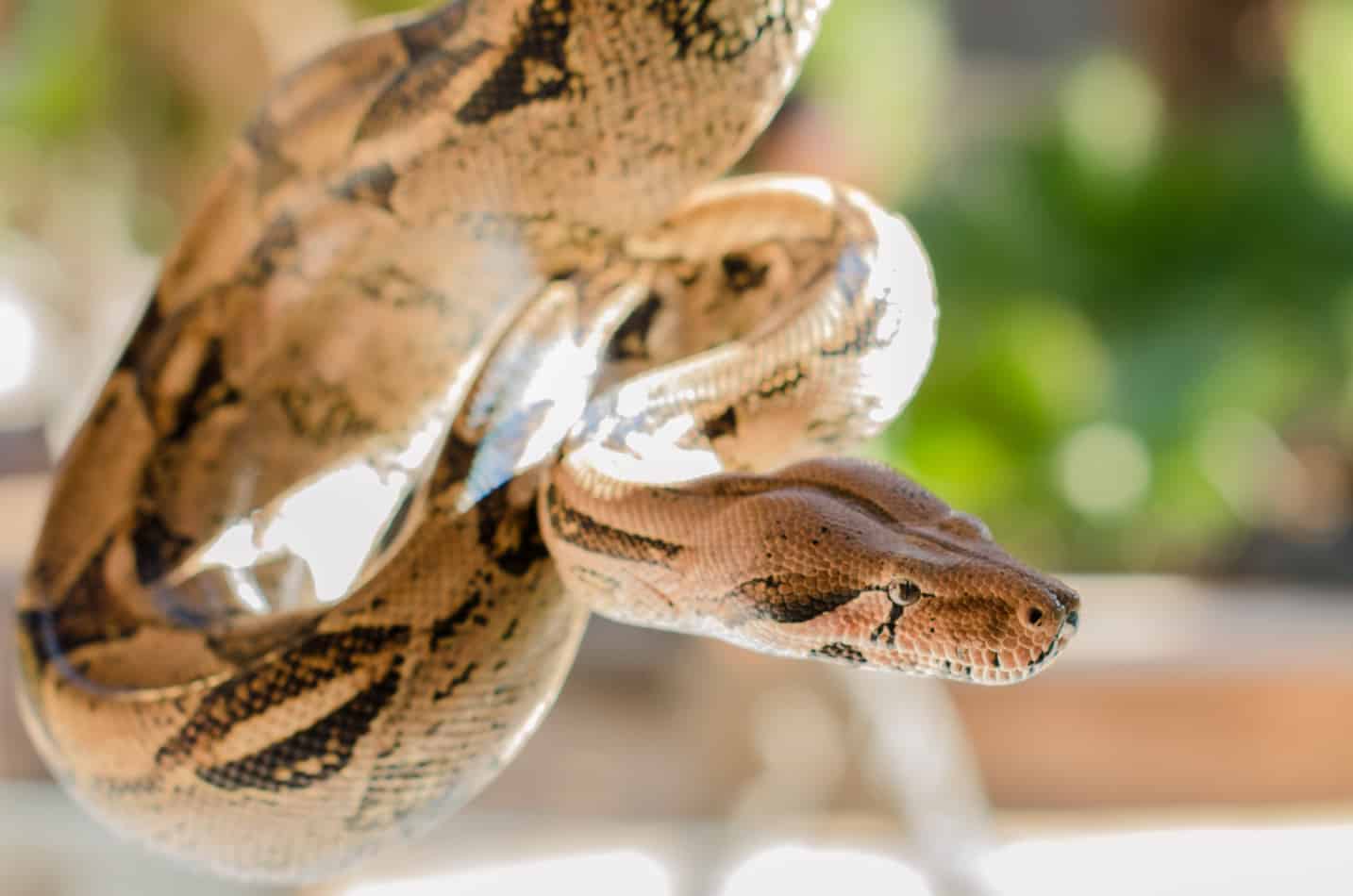
Finally, Boa Constrictors who are known as Boa Constrictor imperator make wonderful pets with an exotic pull. These snakes are usually found in areas of South America, primarily in tropical areas.
These snakes can grow between five and ten feet in length. Learn more about their length and how long they can get in this article that we recently wrote. We talk about the difference in length between male and female boas, as well as the difference between boa constrictors and pythons. Boa constrictors are very docile but can be active and do enjoy being handled. They especially love body heat. Note that if your boa constrictor’s enclosure is above the needed temperature (more than ninety degrees), they may have a bad attitude when being handled.
Boa Constrictors are easily the largest snakes on this list and may be the most difficult to handle because of it. A Boa Constrictor can reach up to thirteen feet long, more than doubling the average height of American males and females.
They can also weigh around sixty pounds, so they’re no cakewalk. These snakes should not be made pets without careful planning, and you should be very prepared to take care of the snake and take precautions against it for your own safety.
Boa Constrictor’s enclosures should be six to eight feet long and around three feet tall. Floor space is more important than height because Boas don’t climb much, especially as they get older and heavier (sixty pounds!).
Like the other snakes on this list, a hide box should be provided for your snake for security reasons. This will help the snake feel safe and private. Also the same is that there is a warm side and a cool side.
Seventy-five degrees for the warm side and eighty-five for the cool side. There are many different types of substrate you can use for a boa constrictor such as store bought substrate, newspaper, carpet, etc.
Much like the California King Snake heating methods, your snake’s terrarium can include heating pads, tape, and/or cables. You should always be aware of the enclosure’s heat level so your snake does not overheat which would cause problems that could result in your snake’s death. As always, a larger bowl of fresh water should be provided for drinking and/or soaking.
It should be noted that Boa Constrictors should not be fed while they are acclimating due to safety reasons for your snake. Acclimation is a very stressful time for your snake when it is first brought into your home. It will be okay without food during that time.
When you start feeding your boa, it should be fed quality rodents such as mice and rats of a good medium size. Enough to leave a lump after eating but not so much that your snake may regurgitate it.
Boa Snakes are wonderful pet snakes for the snake-lover. They are a handful (no pun intended) so it is important to take extra care with them. Especially because Boa Constrictors can live up to between twenty-five and thirty years!
Ready to adopt a Boa Constrictor? Read this first to learn 27 fun facts you probably didn’t know about Boa Constrictors.
Why Are These Snakes So Popular?
Snakes in general can be really great pets. They are hypoallergenic, they don’t smell, and they don’t need the kind of maintenance that a dog needs.
Some snakes, like the ones listed above, make better pets than some of the other breeds out there. After all, a little corn snake would make a much easier and safer pet than an anaconda.
The reason some snakes make more popular pets than others is because many snakes are fairly low maintenance. Others require more work or space than others. Some snakes are also known for being aggressive, like rattlesnakes.
Knowing that the snake you are buying as a pet is one that many other people have, and can manage well, can be very comforting. All of the snakes on this list are non-venomous, which likely contributes to their popularity as well.
Once you know you are capable of taking care of the kind of snakes on this list, the reasons for popularity come down to appearance and size more than anything. Most of the snakes on this list (aside from the boa constrictor) are small to mid-size snakes.
This means they are easier for children and adults to handle and won’t take up as much space in your home. The patterns on the snakes’ bodies definitely play into popularity as well. Just look at the colors on those corns snakes. They’re stunning!
Basically, when it comes to snakes as pets, you can safely assume that if a breed is popular as a pet, there is a good reason for it. Individual temperament aside, the snakes on this list have made good pets for other people, so they could easily make a great pet for you. Here, you can find an article we wrote about how to choose the right pet snake for you! Just make sure you do your research on the specific breeds and you will be a great snake parent.
Related Questions
Are pet snakes dangerous? Pet snakes, if handled properly, are just as safe as any dog or cat. If you are bitten by your snake, it may have been out of fear or nervousness or potential poor care. Be sure to clean your wound and know if your specific snake is venomous or not. If venomous seek immediate help by going to your local emergency room or calling your local emergency support services.
Do snakes recognize their owners? It is supposed that pet snakes recognize their owner not by sight but by scent. It is also known that your pet snake can direct your heat signature to determine who their owner is. However, a snake will not recognize you by sight and will know you more
What are the smallest pet snakes? There are many pet snakes such as the most popular listed above. If you are looking for pet snakes that are on the smaller side here are four of the smallest pet snakes:
- Bimini Blind Snake
- Ringneck Snake
- Western Hognose Snake
- Ball Python
